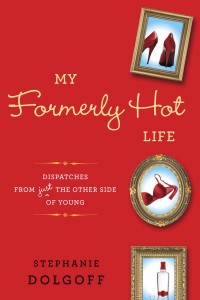|
Of Two Minds, One Body
by Stephanie Dolgoff
Excerpted from
My Formerly Hot Life: Dispatches from Just the Other Side of Young by Stephanie Dolgoff Copyright © 2010. Excerpted with permission by Ballantine Books.
Of Two Minds, One Body
As you might imagine, the realization I had in my late 30s--that I was no longer young--hardly made me want to go skipping through a wheat field, arms open wide and ready to embrace my future as an aging woman and all the joy and wisdom and reverence from society to which my new status entitled me.
Instead, coming to terms with the fact that I am in a new category of person, that of the not-young woman, was a herky-jerky, one-step-forward-two-steps-back trippy odyssey fraught with insecurity, hypocrisy (societal), hypocrisy (my own), contradictory messages and conflicting, shifting priorities.
One moment, I was laughing with my children, enjoying my work, or walking down the street on a crisp, clear day just glad to be wise and aware enough to appreciate how lucky I was and the enormity of all that I've built and have been gifted. This understanding of my good fortune came with age, and the fact that nothing lasts forever only enhanced the experience for me. I felt as wealthy as I could ever hope to be. And, not coincidentally, I felt beautiful.
Then, later that very same day, I'd examine my tired eyes in that stupid 15X magnification mirror I keep in the bathroom. The skin underneath was newly adorned with tiny white bumps and dark patches, a blue vein that I'd barely noticed before appears to be throbbing cartoonishly and my skin was sallow and looking subtly slack. A mild panic mixed with exhaustion set in. I started to ponder "what can be done" about it all. I completely forgot that that same face had only recently been smiling and laughing, and, as some cheesy Hallmark plaque over a receptionist's desk I read once rightly said, "A smile is an instant face-lift." I was back to looking at my outsides, my brain churning with ways to keep them from revealing that too much has changed with time. Only hours before, I was splashing happily around in all that had changed internally for the better over the years.
It's a little schizo, I know, but it's where I'm at. I am of two minds about the way I look (which, not for nothing, is just fine), the way I no longer look and how important it is to me as I get older. I am of two minds, and both of them overthink things. I see no solution save learning to roll with how I feel at any given time. So that's what I'm doing, bumpy though the ride sometimes is.
And bumpy though my body sometimes is! Always is! Not that it was ever perfectly smooth, but with pregnancy and childbirth, creeping weight gain and the general southern migration of all the fleshy bits, it isn't hanging together quite the way it used to. I've been resisting incorporating "shapewear," which is what they're calling girdles these days, into my regular underwear routine, as many of my friends have, because I find it uncomfortable. But of course there's that other definition of comfort, as in, I'd like to feel comfortable wearing that slinky sheath dress, and I don't because I'm too fat/rolly/whatever, which can be just as powerful a consideration.
Superstrong body squishers like Spanx are the nexus of these two ideas: Can you smush your body into a physical shape that makes you feel psychologically comfortable wearing a sexy dress, and still feel physically comfortable enough to sit, stand and wriggle out of it when you have to go to the ladies' room? There is shapewear for virtually every part of the body, including one's pelican-beak-like upper arms.
And then there's that third comfort, which is to say, ideologically comfortable with the idea that a woman should have to endure one second of physical discomfort for psychological comfort. Why can't I feel sexy in a sexy dress the way I am, which is admittedly a bit on the loosey-goosey side?
I recently had an event at which I wanted to look my best, so I went and got some Spanx, but my two minds had a good long argument about it. On the one hand, shapewear (remember Scarlett O'Hara getting her corset stays tightened to bring her waist to 17 inches?) is a godsend to many women. Part of me thinks, whatever gets you through the day, date, red carpet paparazzi gauntlet or Civil War is fine.
But there's another part of me that resents having to even think about wrapping my body in sausage casing in order to feel I look acceptable. I mean, really! At 43, I am smarter, cooler, funnier and more comfortable with myself and the world than I've ever been, and yet I am considering tucking my belly rolls into a pair of Power Panties or something called a Slim Cognito, which goes from my knees to my sternum and hooks to my bra so it won't roll down when I exhale? Weirdly, the grumpier I get about the idea of Spanx, the better I feel about being my age now. It wouldn't have occurred to me to resent it when I was younger—I was too busy feeling fat.
Like most women who give it any thought, I am torn between wanting to feel like I am OK without binding and just plain wanting to look sleek in a sheath dress. Which is why I broke down and got the damn Spanx, which I didn't end up wearing because I skipped the event. In the end, the "to shapewear or not to shapewear" question comes down to the comfort versus vanity balance— i.e., how much discomfort are you willing to endure in exchange for looking smooth and thinner (because they do work!) on any given day. For me, the older I get, the more I tend toward comfort and away from dresses that require me to smooth my flab. So I wear a slightly looser dress and still look good and can digest my food.
Given the screwy world women our age must navigate, I'm glad such garments exist, I suppose. The last thing any woman should have to be worrying about is her lumpy butt, ever, and if a pair of Spanx gives her a reprieve, then fine. I just wish none of us was worrying about it in the first place, so shapewear would be obsolete.
It's not just my body that I'm of two minds about, either. Lately I've been getting bad face days, maybe twice a week, usually when I haven't had enough sleep. Unlike bad hair days, these are much harder to disguise; there is no headband or gel or baseball hat for a bad face day. There are no Spanx for your face. Sure, there are creams and serums that over time might make a drop of a difference. And there are expensive poisons that doctors might inject here and there like the guy at the automotive body
shop might bang out dings and dents, if you have the money and the inclination.
But on any given morning, if you wake up with creases and craters for pores, and dark chocolate croissants under your eyes, and blemishes not next to but on your little wrinkles, and broken capillaries—oh, yes, and let us not forget, whiskers, the man kind—you've got no choice but to stare yourself down, go through your ablutions and then start spackling on the concealer if you have vanity enough to do so. Which, God knows, I do.
Still, if I said I was loving the way things are trending, my nose would grow and that would make a bad face day much worse.
There was an ad for a face product that popped up on the right side of my Facebook page about a year ago that made my arm hair stand up. It said, "Murder Wrinkles". "Murder? Isn't that a little harsh, even for something so unwelcome as a wrinkle? Good people disagree on whether the death penalty is appropriate for exponentially more heinous crimes than making someone (who is, after all, not a teenager) look her age.
I kept an eye out for similar language in other appearance and anti-aging marketing and articles. Here's what else I came across: "destroy" (mostly with regard to fat cells), "blast," "torch," "melt" (fat and calories) and "annihilate" (belly fat, in particular). Do the employers of these words forget that the wrinkles and flab are actually attached to human beings? I'm looking down at my belly rolls right now. I've often wished they'd magically vanish or be sloughed off with a loofah in the shower, but these words make me want to hide them like Anne Frank until the war is over.
The violence in these words reminds me of when I was a teenager and so consumed with self-loathing that I tried to starve my body so it would disappear. When that didn't work, I tried to torture it into thinness by overexercising and throwing up. My body didn't like that too much, not to mention my psyche or my tooth enamel. I won't tell you that my body and I got on the Love Train and rode it happily ever after to the terminus together, but when I gradually dropped the adversarial "me versus it" attitude, "it" became a part of me again, and we began to work together to at least be healthy and try to get along. For the most part, we have.
And here we are, 25 years later, and I'm being told to blast
and destroy and murder it? I like myself too much to do that. The thing I've learned in these several decades is that as looks-concerned as I remain, there is a soul-sucking element to caring too much, to worrying too much and to giving too much credence to the external, and hard as it is to do some days, it is to be resisted.
***
Excerpted from
My Formerly Hot Life: Dispatches from Just the Other Side of Young by Stephanie Dolgoff Copyright © 2010. Excerpted with permission by Ballantine Books.


Stephanie Dolgoff is a contributing editor at Parenting. Before that, she was a contributing editor at Real Simple, health director and features director at SELF magazine, and prior to that, executive editor and senior contributing editor at Glamour. She's written for "O" The Oprah Magazine, Fitness, Health, Parents, Redbook, Seventeen, CosmoGirl, Ladies Home Journal, Prevention, American Photo, and many others. For five years she authored a monthly sex column for teens, Ask Anything, for the now defunct YM magazine. Her articles have also appeared in the New York Times and the New York Post.
Stephanie has won several awards for her writing, and a section she helped to oversee, SELF magazine’s 2005 Breast Cancer Handbook, won the ASME award in the category of personal service. Her work has also been published in several books, including The Elephant in the Playroom (Penguin), and The Enlightened Bracketologist (Bloomsbury). One of her essays appeared in Behind the Bedroom Door (Delacorte), in 2008.
Stephanie was born and raised in New York City, where she still lives with her husband and twin girls. She attended Wesleyan University in Middletown, CT.
For more information, visit Stephanie's web site at www.formerlyhot.com
Click below to e-mail this article to a friend
or to post a link on your favorite sites.
Thank you!
 |
|
